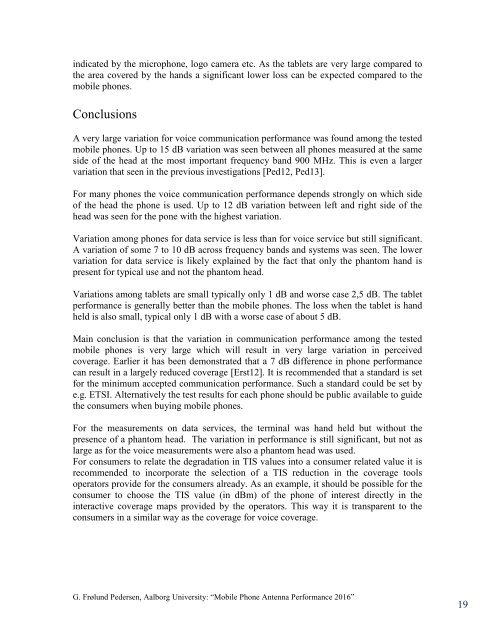Create successful ePaper yourself
Turn your PDF publications into a flip-book with our unique Google optimized e-Paper software.
indicated by the microphone, logo camera etc. As the tablets are very large compared to<br />
the area covered by the hands a significant lower loss can be expected compared to the<br />
mobile phones.<br />
Conclusions<br />
A very large variation for voice communication performance was found among the tested<br />
mobile phones. Up to 15 dB variation was seen between all phones measured at the same<br />
side of the head at the most important frequency band 900 MHz. This is even a larger<br />
variation that seen in the previous investigations [Ped12, Ped13].<br />
For many phones the voice communication performance depends strongly on which side<br />
of the head the phone is used. Up to 12 dB variation between left and right side of the<br />
head was seen for the pone with the highest variation.<br />
Variation among phones for data service is less than for voice service but still significant.<br />
A variation of some 7 to 10 dB across frequency bands and systems was seen. The lower<br />
variation for data service is likely explained by the fact that only the phantom hand is<br />
present for typical use and not the phantom head.<br />
Variations among tablets are small typically only 1 dB and worse case 2,5 dB. The tablet<br />
performance is generally better than the mobile phones. The loss when the tablet is hand<br />
held is also small, typical only 1 dB with a worse case of about 5 dB.<br />
Main conclusion is that the variation in communication performance among the tested<br />
mobile phones is very large which will result in very large variation in perceived<br />
coverage. Earlier it has been demonstrated that a 7 dB difference in phone performance<br />
can result in a largely reduced coverage [Erst12]. It is recommended that a standard is set<br />
for the minimum accepted communication performance. Such a standard could be set by<br />
e.g. ETSI. Alternatively the test results for each phone should be public available to guide<br />
the consumers when buying mobile phones.<br />
For the measurements on data services, the terminal was hand held but without the<br />
presence of a phantom head. The variation in performance is still significant, but not as<br />
large as for the voice measurements were also a phantom head was used.<br />
For consumers to relate the degradation in TIS values into a consumer related value it is<br />
recommended to incorporate the selection of a TIS reduction in the coverage tools<br />
operators provide for the consumers already. As an example, it should be possible for the<br />
consumer to choose the TIS value (in dBm) of the phone of interest directly in the<br />
interactive coverage maps provided by the operators. This way it is transparent to the<br />
consumers in a similar way as the coverage for voice coverage.<br />
G. Frølund Pedersen, Aalborg University: “<strong>Mobile</strong> <strong>Phone</strong> <strong>Antenna</strong> <strong>Performance</strong> <strong>2016</strong>”<br />
19



